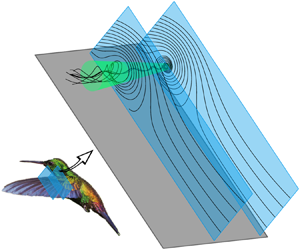Article contents
A theory on leading-edge vortex stabilization by spanwise flow
Published online by Cambridge University Press: 30 August 2023
Abstract

Natural flyers are capable of producing excessive lift via a stabilized leading-edge vortex (LEV), which appears to linger above the wing for a longer duration than it could in an equivalent two-dimensional flow. Previous studies found this stabilization behaviour closely related to a spanwise flow along the LEV axis; however, it is still debatable how the spanwise flow influences the LEV stability. In this work, potential flow theory is adopted to model an LEV attached to a flat-plate wing. To account for the spanwise flow effect, we propose a finite-area sink (FAS) model which allows the dynamical interaction between co-located LEV and spanwise flow. Through linear stability analysis of the dynamical system associated with the LEV movement, we arrive at a stable spiral-sink type of equilibrium, which is the first mathematical evidence supporting LEV stabilization by spanwise flow. It is further concluded that the LEV stability can be enhanced by either increasing the strength or decreasing the cross-section area of the spanwise flow.
- Type
- JFM Rapids
- Information
- Copyright
- © Shanghai Jiao Tong University, 2023. Published by Cambridge University Press
References
- 3
- Cited by



